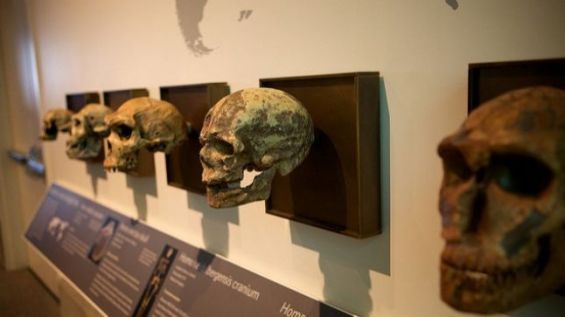Since forever, Morocco has been a great platform for scientists, researchers and curious academics. And the Kingdom delivered, from ancestry to planets, fossils and crazy-looking insects, many scientific discoveries were born on its soil.
Here, we are putting five of them under the spotlight, the most groundbreaking ones, which changed the course of history and modern science. So without further ado, let's discover these.
North Africans are the cousins of Northern Europeans
No one would have guessed that North Africans are, somehow, connected to the indigenous people of Northern Europe. Although it may sound strange, it is nonetheless a fact.
In a 2005 groundbreaking study, a group of international researchers found out that, genetically-speaking, Berbers and Saami people, Finno-Ugric people inhabiting Finland, are related. Entitled «Saami and Berbers—An Unexpected Mitochondrial DNA Link», the scientific research revealed, for the first time, that Saamis and Berbers «share an extremely young branch, aged merely approximately 9,000 years».
As surprising as it may seem, this unexpected finding shows «a direct maternal link between those European hunter-gatherer populations (Saamis) and the Berbers». But not just that, the study was also a way of determining how these populations lived thousands of years ago.
The same study, which focused on Moroccans, Algerians and Saamis, revealed in its findings that southwestern Europe (which stretches from Spain to France) and North Africa were the source of Late-Glacial (13,000 years ago) expansions of hunter gatherers that repopulated northern Europe.

Mzora, the stone circle city
It used to be a city, a stone circle city that was overlooked by scientists for hundreds of years. Located near the city of Asilah, the Mzora site is a gem to archaeologists interested in megalithic structures. Although it is deemed «mysterious» and there is little available information about its very existence, the oldest study that focused on the structure dates back to the 1970s.
According to Ancient Origins, the study was mainly interested in guessing who built this giant circle. «The [surveyance] did show that the site was not only extraordinary in itself, but also remarkable for the fact it changes the history of megalithic structures in Europe», the same source revealed.
This study showed, however, that the Moroccan structure «was not built independently of the European megaliths, but remarkably that it either was built by the same culture or is evidence of significant interaction between the two regions», referring to Europe and North Africa.
The stone circle, which is composed of 168 remaining stones and is spread across a 55-meter diameter, has a story to it that could have been the reason why scientists were fascinated with it. Legend has it that Mzora is the tomb of Antaeus, a giant in Greek mythology.
According to ancient origins, «Mzora was first described by the Roman general Quintus Sertorius in the 1st Century AD as he was told it was the tomb of Antaeus – a legendary giant who was slayed by the heroic demigod Hercules as one of his labors». A tomb or a city, there is no doubt that Mzora still has a lot to say about Morocco’s history and a lot to offer to curious scientists.

Planets that you can only observe when you are in Morocco
We all agree that Morocco has always been the place to be for scientists willing to change the course of history and research. It also stands for astronomers and anyone interested in space, planets and giant stars. In February 2017, a NASA scientific mission in Washington announced the discovery of TRAPPIST-1, an ultra-cool red dwarf star much more massive than planet Jupiter.
Thomas Zurbuchen, the associate administrator of the Science Mission Directorate at NASA Headquarters in Washington, said that «the discovery gives us a hint that finding a second earth is not just a matter of if but when».
But the most exciting thing about this discovery is that this star was spotted by the Oukaimeden Observatory in Morocco’s Atlas Mountains. And there is even more to the story as the results of this discovery reveal that «there is a lot of potential out there—life may not be exclusive to Earth».
This discovery steers us away from the old idea that we are the center of the universe: «if another form of life exists someplace else, it would mean that there is not one single point of creation, which would be very important from a philosophical point of view. From a scientific point of view, [the value of the research] is in all the different methods that have evolved to …discover these new worlds», says Benkhaldoun Zouhair, director of the Oukaïmeden Observatory, Cadi Ayyad University in Morocco and co-author of the study.
A year later, the Oukaimden Observatory in particular and Morocco in general were referred to in another groundbreaking discovery. This time, the Morocco lab observed a small asteroid-like planet, which was at the heart of many astronomical studies.

Cebrennus Rechenbergi, a spider like no other
In addition to the many fossils and remains of ancient animals found in Morocco, the country distinguished itself by being home to a unique spider. In May 2014, the Kingdom was widely mentioned by scientific journals and articles in awe at the Cebrennus Rechenbergi.
The latter is a spider like no other. It is a skilled acrobatic Saharan spider. Native to Morocco’s Erg Chebbi, the Cebrennus has been described as «a gymnast» that «propels itself off the ground, followed by a series of rapid flic-flac movements of its legs», explained Dr Peter Jäger from Senckenberg Research Institute.
«This gives the spider great flexibility – uphill, downhill or on level ground, Cebrennus Rechenbergi can move along with ease. It displays this behavior when provoked, e.g., by a congener, a camel spider, a scorpion or a human», he added.
The unbelievable abilities of this Moroccan spider made it the star of the show. In fact, the discovery influenced biomimetic robot research in the world.

Morocco, the cradle of humanity
Since 2017, everybody knows that Morocco is the cradle of humanity, thanks to one major discovery. The National Institute of Archeology and Heritage Sciences then announced to the world the discovery of the remains of Homo sapiens, dating back about 300 000 years ago.
The team behind these findings, namely Professor Abdelouahed Bennacer, Jean-Jacques Hublin of the Max Planck Institute of Evolutionary Anthropology (Leipzig, Germany) and the College of France (Chair of Paleoanthropology), revealed that the remains belonged to the oldest Homo sapiens ever known.
The new excavations undertaken in the site since 2004 have made Jbel Irhoud the oldest and richest African deposit of the Middle Stone Age, which documents the first evolutionary phase of our species.
Now that you have an idea about the five most groundbreaking discoveries in Morocco, which one is your favorite ?





 chargement...
chargement...













